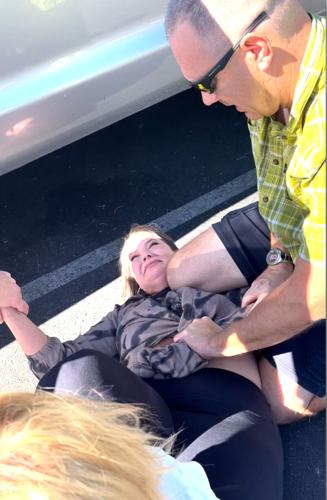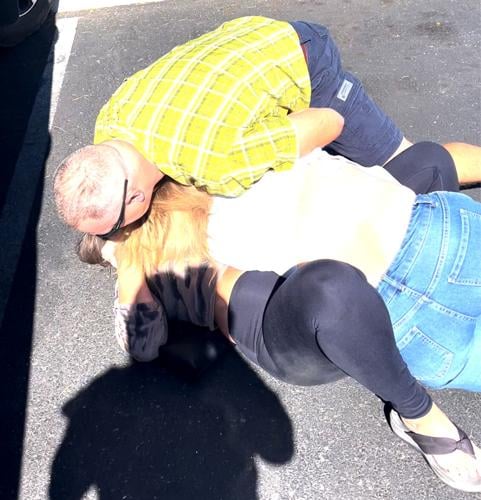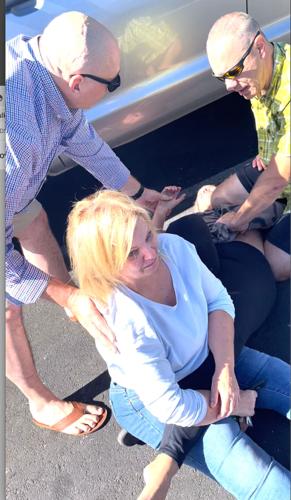When a man threw her daughter down in a Tucson parking lot, Michelle Aloisi couldn’t help but act.
It was Nov. 14, a nice Sunday at noon outside the Culinary Dropout restaurant. Aloisi, who is 62 and a registered nurse, had finished enjoying a brunch with her two adult daughters. Shocked by the sudden turn of events, she dove in to help.
“I knew my strength wouldn’t match his, but I thought maybe if I pull his shirt where it gets tight around his neck, maybe he would have to let go of her. But that didn’t work out that way. I’m telling him to leave her alone. Next thing I know he’s got me by the hair.”
The man pulled Aloisi down, too, Aloisi and her daughters said in an interview Tuesday. A video of part of the incident shows the man pinning the two of them to the parking lot together. Aloisi yelled to her other daughter, Nicole Whitted: “Call 911, call the cops!”
The man responded: “I am the f—ing cops!”

Robert Szelewski holds down Michelle Aloisi, 62, and daughter Brittany Aloisi-Wiles, 39. The off-duty officer disputes chest-bumping the younger woman.
Even then they didn’t believe him. But it was true: He is a Tucson police officer. They found that out during five hours of subsequent interviews and investigation outside the restaurant, 2543 E. Grant Road.
The upshot of that investigation shook the trio’s faith in law enforcement and could end up costing the city a significant settlement if they sue. The incident and its aftermath are also proving to be a test of the Tucson Police Department’s ability to police itself.
Kneeling on neck
Aloisi’s two daughters live in Yuma but came to Tucson to celebrate their mother’s birthday that weekend. Nicole Whitted, 40, owns a landscape materials business in Yuma, and Brittany Aloisi-Wiles, 39, is a registered nurse in critical care there.
They’re not people you would normally hear complaining about police.
“I brought my children up to respect law enforcement, go to law enforcement because they are your ultimate protection,” Aloisi said. “Our experience has said that’s not really true.”
The story of what happened Nov. 14 I heard largely from Aloisi, Whitted and Aloisi-Wiles in a Zoom interview Tuesday. They also have a recording of a police interview of Nicole Whitted, which I’ve listened to.
Whitted also took a disturbing five-minute video of the latter part of the incident, which shows the officer involved, Robert Szelewski, kneeling on the neck of her sister Brittany Aloisi-Wiles. After 2020 in Minneapolis, it’s not the sort of scene any of us wanted to see again.

An image taken from a video of off-duty Tucson police Officer Robert Szelewski with his knee on Brittany Aloisi-Wiles, 39, in the parking lot of Culinary Dropout restaurant on Nov. 14, 2021.
Tucson police have not yet provided the reports on the incident, and Szelewski would not do an interview now, his attorney said, because the department is still conducting an internal investigation. But Szelewski has his own version of events that differs in a couple of important ways.
Still, Aloisi and her daughters offer a compelling and consistent account of what led to two of them being pinned to the ground by an off-duty officer as one of them said she couldn’t breathe.
‘What are you going to do?’
Aloisi and her daughters were walking across the parking lot after brunch, they said, when a vehicle approached them fast before the driver abruptly stopped.
The driver, a man, waved his arms at them and appeared to be yelling, they said, though his windows were closed. The women waved their arms and yelled back at him. Aloisi has a leg problem that prevents her from walking fast after sitting for a length of time, she said.
As they continued to their cars, they said, the driver pulled quickly into a parking space and jumped out of his silver SUV, walking toward the rear of the vehicle. Though four members of his family were also in the SUV, none got out.
“He zoomed into that back parking spot, jumped out of his car, threw his hands up in the air and screamed ‘Just f—ing walk’ at us,” Nicole Whitted said.
The two daughters were walking toward his car and responded heatedly in kind, they said, saying that their mother can’t walk fast.
Whitted recalled, “He starts to advance toward me. My sister (Brittany) saw it. She kind of cut it off in between. He’s advancing toward the end of his car. He’s screaming at us and she’s going ‘What are you going to do?’ or something along those lines. Then he starts to go ‘What are you going to do, what are you going to do?’ then chest-bumps Brittany.” This is a key point that Szelewski disputes.
“Then he took her down. He grabs her by the back of the neck. Took her down violently to the ground.”
Here’s how Aloisi-Wiles explained it: “He was saying, ‘What are you going to do,’ inches from my face. I was so surprised by such an aggressive reaction. He was escalating, he was getting so mad.
“When he bumped into me, it was a split second before he had me by the back of the neck and subsequently on my neck on the ground.”
Then Aloisi tried to intervene and he pulled her down, too.
“At this point he’s holding my mom down with one arm,” Nicole Whitted said. “He has Brittany down with his forearm across her throat. He’s holding her down that way. My mom is screaming ‘Call 911, call the cops.’
‘I was yelling I couldn’t breathe’
It had been a minute or two at this point, and Whitted picked up her mother’s phone, which was spilling out of her purse, to start taking video.
The 5-minute, 2-second video shows Szelewski on top of the two women, pushing them down. A bystander shows up, a man perhaps 40 years old, and appears to assess the situation intelligently.
Bear in mind, a different bystander might have justifiably barreled Szelewski over, punched him, kicked him or potentially even shot him as these women screamed in distress. This bystander, though, crouches down and calmly asks Szelewski to let the women up.
“No, they already assaulted me so we’re not getting up until ...” Szelewski responds before the audio becomes hard to understand. Presumably he wanted to wait till police showed up.
The bystander asks for ID to confirm Szelewski is an officer, and Szelewski tells the bystander to pull out his wallet as he maintains his grip.
One minute and 28 seconds into the video, which, again, began a minute or two after the incident did, the bystander asks Szelewski once more to release the women: “C’mon, please.”
Another 15 seconds later, Szelewski releases Michelle Aloisi, but shifts and appears to put his knee on her daughter’s neck.

A bystander, left, asks off-duty Tucson police Officer Robert Szelewski to let Brittany Aloisi-Wiles, 39, get up. Shortly before, the bystander's requests — "c'mon, please" — had resulted in the officer releasing his hold on Michelle Aloisi, 62.
Just over two minutes into the video, the bystander kneels next to Szelewski and says, “Officer, officer you need to let her off the ground and I’ll ensure she stays here with you.”
Szelewski finally removes his knee from Brittany Aloisi-Wiles.
“When he got my mom off me, that’s when the cop completely shifted and had his knee on my neck,” Aloisi-Wiles recalled. “I was yelling I couldn’t breathe and all of that. That’s when he even got angrier.”
“It took a little more convincing for him to finally get off my neck,” she said.

Still photo taken from a video of off-duty Tucson Police Officer Robert Szelewski in a confrontation with Michelle Aloisi, 62, and daughter Brittany Aloisi-Wiles, 39, in the parking lot of Culinary Dropout restaurant on Nov. 14, 2021.
In the aftermath, as Whitted took video, Szelewski referred to the situation with some disgust as “absolutely avoidable.”
When police arrived, a long process of investigation began, with a troubling result.
‘No intention of escalating’
Of course, Szelewski has a version of events that is different in some key details. This is how his attorney, Mike Storie, explained it:
“He’s just there for a family event. These women started the confrontation by initially blocking his travel, then confronting him with some claim that he was driving too fast, which he denies.
“He gets out and he’s confronted by them. He had no intention of escalating or having this go further. The one woman chest-bumps him, and that’s when he decided that he needed to take her into custody.”
The police took five hours looking into the incident that afternoon. In the end, they did not bring any charge against Szelewski — no citations, no nothing.
Instead, they cited Brittany Aloisi-Wiles for a misdemeanor, disorderly conduct. Specifically, her citation says it is for “disorderly conduct — fighting.”
The law that police say she broke reads like this: “A person commits disorderly conduct if, with intent to disturb the peace or quiet of a neighborhood, family or person, or with knowledge of doing so, such person ... engages in fighting, violent or seriously disruptive behavior.”
I pressed Assistant Police Chief Michael Silva on how the investigators ended up citing Aloisi-Wiles. He said that security video from the restaurant did not show how the physical contact began, but Aloisi-Wiles’ account and the video made clear she walked out of her way to confront Szelewski.
With disorderly conduct, he said, you have “a set of people minding their own business. A person goes out of their way to come to where these people are in a general state of peace.
“Their peace is disturbed by the actions of another person. That’s the situation we have here.”
Aloisi-Wiles scoffed at the idea that she had disturbed Szeleswki’s peace. And I told Silva I have a hard time believing she would have chest-bumped the much larger Szelewski.
“I think you’d be surprised by the number of circumstances we see where females are the aggressors in what turn out to be violent encounters,” Silva said.
That’s probably true. But I still find the deference and breaks given to this officer suggestive of protecting a colleague.
Given benefit of the doubt
Consider the citation Aloisi-Wiles was issued. She was not charged with assault, which means police had insufficient evidence to say that she touched Szelewski first.
But they have ample evidence that Szelewski threw her to the ground in response to what they termed disorderly conduct. The logic seems to be that he was justified in reacting physically to a non-physical disturbance of his peace.
I question whether you or I would get that benefit of the doubt.
Szelewski also pulled down a second woman, Michelle Aloisi. When he did so, she was justifiably trying to get what appeared to be an aggressive, violent stranger off her daughter. She didn’t know he was a police officer, not that it excuses his actions, since he hadn’t identified himself.
For you or I, the attack on Aloisi could well be a second assault charge. For Szelewski, it was excused.
Beyond criminal culpability there is also the question of Szelewski’s temperament. This police officer, even if he actually were bumped by Aloisi-Wiles, could easily have taken a step back. He could have identified himself. He could have gotten back in his car if he felt threatened.
But he chose escalation — exactly what Tucson officers are taught not to do these days. And after making the choice to take down not just one woman but two, he put his knee to the neck of one, appearing angry even when talked down gently by a calm bystander.
It truly was “absolutely avoidable” — on the officer’s part.
Now, the Tucson Police Department will have a chance to show it can really investigate its own — in an administrative investigation, at least.
But the department has already raised serious questions about its ability to police itself in the criminal investigation, in which an apparent victim became a perpetrator, and an apparent perpetrator became a victim.

Tim Steller, Metro columnist for the Arizona Daily Star.









